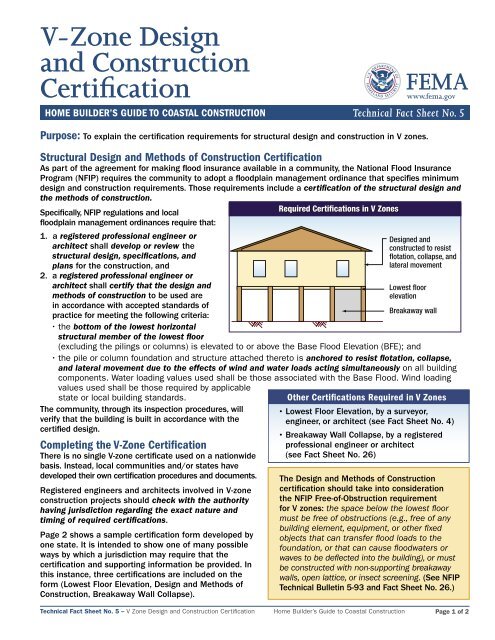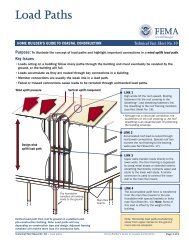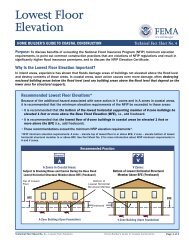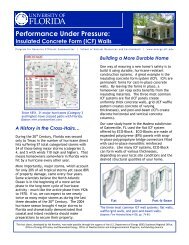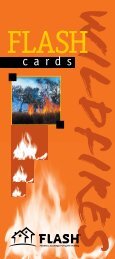V-Zone Design and Construction Certification
V-Zone Design and Construction Certification
V-Zone Design and Construction Certification
Create successful ePaper yourself
Turn your PDF publications into a flip-book with our unique Google optimized e-Paper software.
V-<strong>Zone</strong> <strong>Design</strong><strong>and</strong> <strong>Construction</strong><strong>Certification</strong>www.fema.govHOME BUILDER’S GUIDE TO COASTAL CONSTRUCTION Technical Fact Sheet No. 5Purpose: To explain the certification requirements for structural design <strong>and</strong> construction in V zones.Structural <strong>Design</strong> <strong>and</strong> Methods of <strong>Construction</strong> <strong>Certification</strong>As part of the agreement for making flood insurance available in a community, the National Flood InsuranceProgram (NFIP) requires the community to adopt a floodplain management ordinance that specifies minimumdesign <strong>and</strong> construction requirements. Those requirements include a certification of the structural design <strong>and</strong>the methods of construction.Specifically, NFIP regulations <strong>and</strong> localfloodplain management ordinances require that:1. a registered professional engineer orarchitect shall develop or review thestructural design, specifications, <strong>and</strong>plans for the construction, <strong>and</strong>2. a registered professional engineer orarchitect shall certify that the design <strong>and</strong>methods of construction to be used arein accordance with accepted st<strong>and</strong>ards ofpractice for meeting the following criteria:• the bottom of the lowest horizontalstructural member of the lowest floor(excluding the pilings or columns) is elevated to or above the Base Flood Elevation (BFE); <strong>and</strong>• the pile or column foundation <strong>and</strong> structure attached thereto is anchored to resist flotation, collapse,<strong>and</strong> lateral movement due to the effects of wind <strong>and</strong> water loads acting simultaneously on all buildingcomponents. Water loading values used shall be those associated with the Base Flood. Wind loadingvalues used shall be those required by applicablestate or local building st<strong>and</strong>ards.The community, through its inspection procedures, willverify that the building is built in accordance with thecertified design.Completing the V-<strong>Zone</strong> <strong>Certification</strong>There is no single V-zone certificate used on a nationwidebasis. Instead, local communities <strong>and</strong>/or states havedeveloped their own certification procedures <strong>and</strong> documents.Registered engineers <strong>and</strong> architects involved in V-zoneconstruction projects should check with the authorityhaving jurisdiction regarding the exact nature <strong>and</strong>timing of required certifications.Page 2 shows a sample certification form developed byone state. It is intended to show one of many possibleways by which a jurisdiction may require that thecertification <strong>and</strong> supporting information be provided. Inthis instance, three certifications are included on theform (Lowest Floor Elevation, <strong>Design</strong> <strong>and</strong> Methods of<strong>Construction</strong>, Breakaway Wall Collapse).Required <strong>Certification</strong>s in V <strong>Zone</strong>s• Lowest Floor Elevation, by a surveyor,engineer, or architect (see Fact Sheet No. 4)• Breakaway Wall Collapse, by a registeredprofessional engineer or architect(see Fact Sheet No. 26)The <strong>Design</strong> <strong>and</strong> Methods of <strong>Construction</strong>certification should take into considerationthe NFIP Free-of-Obstruction requirementfor V zones: the space below the lowest floormust be free of obstructions (e.g., free of anybuilding element, equipment, or other fixedobjects that can transfer flood loads to thefoundation, or that can cause floodwaters orwaves to be deflected into the building), or mustbe constructed with non-supporting breakawaywalls, open lattice, or insect screening. (See NFIPTechnical Bulletin 5-93 <strong>and</strong> Fact Sheet No. 26.)Technical Fact Sheet No. 5 – V <strong>Zone</strong> <strong>Design</strong> <strong>and</strong> <strong>Construction</strong> <strong>Certification</strong> Home Builder’s Guide to Coastal <strong>Construction</strong> Page 1 of 2
Note: The V-zone certificate is not a substitute for <strong>and</strong> cannot be used without the NFIP ElevationCertificate (see Fact Sheet No. 4), which is required for flood insurance rating.Technical Fact Sheet No. 5 – V <strong>Zone</strong> <strong>Design</strong> <strong>and</strong> <strong>Construction</strong> <strong>Certification</strong> Home Builder’s Guide to Coastal <strong>Construction</strong> Page 2 of 2


